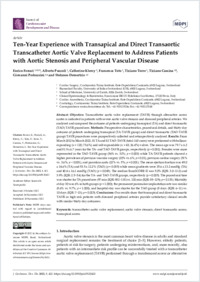Ten-year experience with transapical and direct transaortic transcatheter aortic valve replacement to address patients with aortic stenosis and peripheral vascular disease
- Ferrari, Enrico ORCID Cardiac Surgery, Cardiocentro Ticino Institute, Ente Ospedaliero Cantonale, Lugano, Switzerland ; Faculty of Biomedical Sciences, Università della Svizzera italiana, Switzerland ; School of Medicine, University of Zurich, Zurich, Switzerland
- Pozzoli, Alberto Cardiac Surgery, Cardiocentro Ticino Institute, Ente Ospedaliero Cantonale, Lugano, Switzerland
- Klersy, Catherine Clinical Epidemiology & Biostatistics, Fondazione IRCCS Policlinico San Matteo, Pavia, Italy
- Toto, Francesca Cardiac Surgery, Cardiocentro Ticino Institute, Ente Ospedaliero Cantonale, Lugano, Switzerland
- Torre, Tiziano Cardiac Surgery, Cardiocentro Ticino Institute, Ente Ospedaliero Cantonale, Lugano, Switzerland
- Cassina, Tiziano ORCID Faculty of Biomedical Sciences, Università della Svizzera italiana, Switzerland
- Pedrazzini, Giovanni Faculty of Biomedical Sciences, Università della Svizzera italiana, Switzerland ; Cardiology, Cardiocentro Ticino Institute, Ente Ospedaliero Cantonale, Lugano, Switzerland
- Demertzis, Stefanos ORCID Cardiac Surgery, Cardiocentro Ticino Institute, Ente Ospedaliero Cantonale, Lugano, Switzerland ; Faculty of Biomedical Sciences, Università della Svizzera italiana, Switzerland
- 2022
Published in:
- Journal of cardiovascular development and disease. - 2022, vol. 9, no. 12, p. 422
Transcatheter aortic valve replacement
Aortic valve stenosis
Direct transaortic access
Transapical access
English
Objective: Transcatheter aortic valve replacement (TAVR) through alternative access routes is indicated in patients with severe aortic valve stenosis and diseased peripheral arteries. We analysed and compared the outcome of patients undergoing transapical (TA) and direct transaortic (TAO) TAVR procedures. Methods: Preoperative characteristics, procedural details, and thirty-day outcome of patients undergoing transapical (TA-TAVR group) and direct transaortic (TAO-TAVR group) TAVR procedures were prospectively collected and retrospectively analysed. Results: From March 2012 to March 2022, 81 TA and 82 TAO-TAVR (total: 163 cases) were performed with balloon-expanding (n = 120; 73.6%) and self-expandable (n = 43; 26.4%) valves. The mean age was 79.7 ± 6.2 and 81.9 ± 6.7 years for the TA- and TAO-TAVR groups, respectively (p = 0.032). Females were more represented in the TAO-TAVR group (56% vs. 32%; p = 0.003) while TA-TAVR patients showed a higher prevalence of previous vascular surgery (20% vs. 6%; p = 0.01), previous cardiac surgery (51% vs. 3.6%; p < 0.001), and porcelain aorta (22% vs. 5%; p = 0.001). The mean ejection fraction was 49.0 ± 14.6% (TA) and 53.5 ± 12.2% (TAO) (p = 0.035) while mean gradients were 35.6 ± 13.2 mmHg (TA) and 40.4 ± 16.1 mmHg (TAO) (p = 0.045). The median EuroSCORE-II was 5.0% (IQR: 3.0–11.0) and 3.9% (IQR: 2.5–5.4) for the TA- and TAO-TAVR groups, respectively (p = 0.005). The procedural time was shorter for TA procedures (97 min (IQR: 882–118) vs. 102 min (IQR: 88–129); p = 0.133). Mortality at day 30 was 6% in both groups (p = 1.000); the permanent pacemaker implantation rate was similar (8.6% vs. 9.7%; p = 1.000), and hospital stay was shorter for the TAO group (8 days (IQR: 6–11) vs. 10 days (IQR: 7–13); p = 0.025). Conclusions: Our results show that transapical and direct transaortic TAVR in high-risk patients with diseased peripheral arteries provide satisfactory clinical results with similar thirty-day outcomes.
- Collections
- Language
-
- English
- Classification
- Medicine
- License
- Open access status
- gold
- Identifiers
-
- DOI 10.3390/jcdd9120422
- ARK ark:/12658/srd1326714
- Persistent URL
- https://n2t.net/ark:/12658/srd1326714
Statistics
Document views: 104
File downloads:
- Ferrari_2022_MDPI_jcdd: 121
